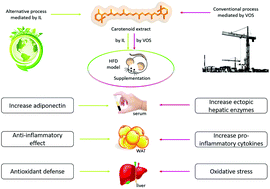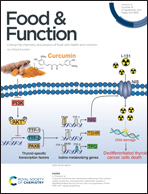Carotenoids obtained from an ionic liquid-mediated process display anti-inflammatory response in the adipose tissue-liver axis
Abstract
Ionic liquids (ILs) have been proposed as more efficient and sustainable solvents to replace volatile organic solvents (VOSs). However, the drawbacks associated with their use are still limiting the regular application of bioactive compounds obtained from the processes they mediate as food ingredients. It is true that the number of ILs approved by the Food and Drug Administration for food applications is still low and mainly focused on the ones from the quaternary ammonium family. However, this trend is changing, judging from the evidence that industries are surpassing overgeneralization about ILs (on price and toxicity) and starting to consider the potential and performance of ILs as solvents. Despite the examples of industries applying ILs in their processes, the use of bioactive compounds obtained from IL-based processes as ingredients in food formulations is still a big challenge. The positive influence of carotenoids on diseases associated or originating from the inflammatory scenario including, among others, obesity, is not new. Moreover, it is also well known that the poorest population worldwide does not have the recommended intake of carotenoids, especially those pro-vitaminic A. In an attempt to help answer this issue, dietary supplements containing adequate doses of natural carotenoids are expected to be the solution, or at least, part of the solution for a healthier life, but also, to reduce hunger. Thus, complete studies evaluating the toxicological potential and the real viability of adding these bioactive compounds in food formulations proving (or not!) their safety to consumers and handlers are highly demanded. This work proposes to investigate the potential of carotenoids extracted from Bactris gasipaes feedstocks mediated by an ethanolic solution of an imidazolium-based IL. Thus, male Wistar rats were randomized in six different groups, supplemented or not by carotenoids extracted by IL or VOS, and fed by control- and/or high-fat-diets (HFD). The adipose tissue-liver axis was studied as a model to investigate the influence of the carotenoids on the levels of inflammation and oxidative stress markers. The main results showed that animals supplemented with carotenoids extracted with IL displayed improvements in serum parameters, besides lower metabolic efficiency, and antioxidant response on the liver, even when fed with HFD. However, animals supplemented with carotenoids extracted by VOS showed higher levels of pro-inflammatory markers and huge oxidative stress on the liver.



 Please wait while we load your content...
Please wait while we load your content...